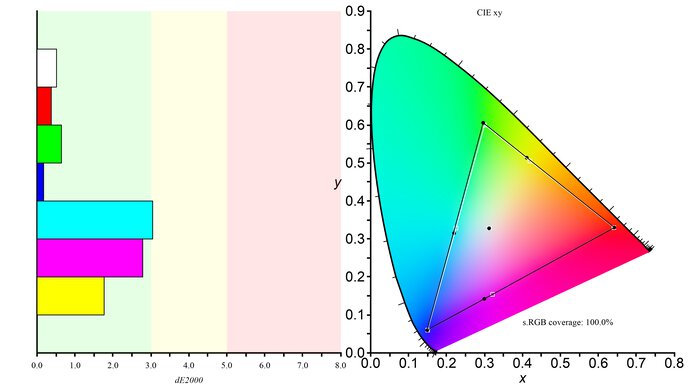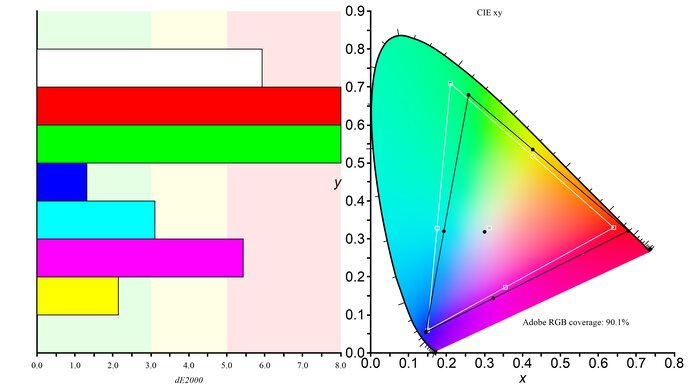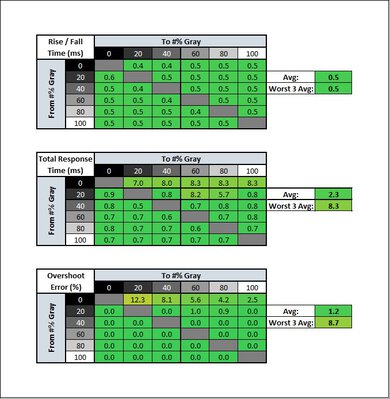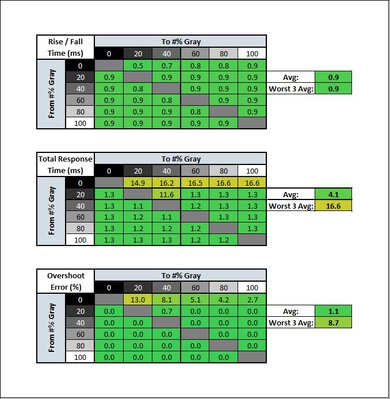The Acer Predator X27U bmiipruzx is a 27-inch OLED gaming monitor that's also sold at Best Buy as the X27U Xbmiipruzx. It has a 1440p resolution and 240Hz refresh rate, using the same panel as competing models that have those same specs, like the ASUS ROG Swift OLED PG27AQDM, LG 27GR95QE-B, and Corsair XENEON 27QHD240. It has features for both gaming and productivity, as it supports FreeSync variable refresh rate (VRR) support and G-SYNC compatibility, and it has DisplayPort 1.4 and HDMI 2.0 ports. On top of that, it includes a USB-C port so you can quickly connect a laptop, and it has a KVM switch that makes it easy to switch between devices and use the same keyboard and mouse.
Our Verdict
The Acer X27U is excellent for most uses. It excels as a gaming monitor because it has a near-instantaneous response time for smooth motion, a fast 240Hz refresh rate, and low input lag at higher refresh rates, but the input lag increases at lower refresh rates. It also displays perfect blacks without any blooming, which is ideal for gaming or watching content in dark rooms. Even if you want to watch content in bright rooms, it has fantastic reflection handling but doesn't get bright enough to fight intense glare. It's also excellent for watching content in HDR as it displays a wide range of colors, but it can't display most vivid colors. Lastly, it's good for the office and excellent for content creation as it has incredible ergonomics and wide viewing angles, but it has text clarity issues, and OLEDs like this one risk permanent burn-in.
- Incredible ergonomics make it easy to adjust.
- Wide viewing angles.
- Fantastic reflection handling.
- Near-instantaneous response time.
- Perfect black levels.
- Limited peak brightness.
- Text clarity issues.
- Risk of permanent burn-in.
The Acer X27U is good for the office, but it has some limitations. It has wide viewing angles and incredible ergonomics, making it very easy to adjust to an ideal position. Also, it has fantastic reflection handling to reduce glare from strong light sources, but it doesn't get bright enough to fight glare in a well-lit office space. Unfortunately, there are text clarity issues as programs don't render text well with its subpixel layout. On top of that, OLEDs like this one risk permanent burn-in when exposed to the same static elements over time, like if you have a taskbar on the screen all the time.
- Incredible ergonomics make it easy to adjust.
- Wide viewing angles.
- Fantastic reflection handling.
- Limited peak brightness.
- Text clarity issues.
- Risk of permanent burn-in.
The Acer Predator X27U is amazing for gaming. It has a fast refresh rate that's ideal for competitive gaming, and it has FreeSync VRR and G-SYNC compatibility to reduce screen tearing. Motion looks smooth at any refresh rate thanks to its near-instantaneous response time, and it has low input lag for a responsive feel at high refresh rates. However, the input lag increases at lower refresh rates, which is disappointing for competitive gaming. While it's excellent for PC gaming, it has limited compatibility with gaming consoles because it doesn't support HDMI 2.1 bandwidth, and it doesn't support VRR with the PS5 or Xbox Series X|S either.
- 240Hz refresh rate.
- FreeSync VRR and G-SYNC compatibility.
- Near-instantaneous response time.
- Low input lag at high refresh rates.
- Perfect black levels.
- Input lag increases at low refresh rates.
- Vertical lines in dark gray screens, like menus.
- Can't take full advantage of current-gen gaming consoles.
The Acer X27U is fantastic for media consumption. Its near-infinite contrast ratio makes it an incredible choice for watching content in dark rooms, as it displays deep blacks without any blooming. It's still good if you want to use it in a room with a few lights around, as it has fantastic reflection handling, but it doesn't get bright enough to fight intense glare in really bright rooms. On the plus side, it has wide viewing angles and incredible ergonomics, making it very easy to watch content with a friend next to you and adjust the screen to an ideal position.
- Incredible ergonomics make it easy to adjust.
- Wide viewing angles.
- Fantastic reflection handling.
- Perfect black levels.
- Limited peak brightness.
- Vertical lines in dark gray screens, like menus.
The Acer Predator X27U is excellent for media creation. It displays a wide range of colors in SDR and has good accuracy before calibration, but you still need to calibrate it for the most accurate colors. Its incredible ergonomics make it easy to adjust, like if you often need to share your screen with a coworker or client, and with wide viewing angles, the image remains consistent from the sides. Unfortunately, it has text clarity issues, and OLEDs like this one risk burn-in when exposed to the same static elements over time.
- Incredible ergonomics make it easy to adjust.
- Wide viewing angles.
- Fantastic reflection handling.
- Good accuracy before calibration.
- Limited peak brightness.
- Text clarity issues.
- Risk of permanent burn-in.
The Acer X27U is excellent for HDR. It displays deep and inky blacks thanks to its near-infinite contrast ratio, and there isn't blooming around bright objects. While it displays a wide range of colors, it has a limited color volume, so not all colors are vivid, and because of its low HDR peak brightness, some highlights don't pop against the rest of the image.
- Perfect black levels.
- Displays wide range of colors.
- No blooming around bright objects.
- Limited peak brightness.
- Can't display most vivid colors.
Changelog
-
Updated Mar 03, 2025:
Added to Additional Features that users have reported a pop-up about image retention can appear after less than four hours of use.
-
Updated Nov 18, 2024:
Added in the Intro and Variants sections that there's a variant sold at Best Buy as the X27U Xbmiipruzx, and it performs the same.
- Updated Apr 12, 2024: Added that the MSI MPG 271QRX QD-OLED has better HDR Color Volume.
- Updated Mar 26, 2024: Added that the LG 27GS95QE-B has higher SDR Brightness.
Check Price
Differences Between Sizes And Variants
We tested the 27-inch Acer X27U (model code bmiipruzx), which is the only size available for this monitor. It's also available at Best Buy as the Acer Predator X27U Xbmiipruzx, and the results are also valid for it. The full model code may vary between regions and even retailers.
| Model Codes | Size | Panel Type | Resolution | Max Refresh Rate |
|---|---|---|---|---|
|
X27U bmiipruzx X27U Xbmiipruzx |
27" | OLED | 1440 | 240Hz |
Our unit was manufactured in April 2023; you can see the label here. We tested it with firmware 2.0.
Popular Monitor Comparisons
The Acer Predator X27U is an excellent gaming monitor. Compared to the rest of the gaming monitor market, it offers everything most PC gamers are looking for, like a high refresh rate, incredible motion handling, and a 27-inch OLED screen. However, it can't take full advantage of gaming consoles, so getting a 4k monitor with HDMI 2.1 bandwidth is a better alternative for those gamers. While it's excellent for gaming, it falls short against competing models that use the same panel, as it doesn't get as bright as the ASUS ROG Swift OLED PG27AQDM, and has higher input lag than the LG 27GR95QE-B. Even if it's the cheapest option out of these 240Hz OLED monitors, only consider it if you don't mind all these trade-offs, or for a bit more, you can get the Corsair XENEON 27QHD240, which supports HDMI 2.1 bandwidth.
See our recommendations for the best 240Hz monitors, the best 1440p gaming monitors, and the best 27-inch gaming monitors.
The Acer Predator X27U bmiipruzx and the AOC AGON PRO AG276QZD2 are 27-inch 240Hz OLED gaming monitors. The Acer is the better option, as it creates a more immersive experience by displaying a wider range of colors. On the other hand, the AOC gets brighter, making it the better choice to use in a well-lit room.
The ASUS ROG Swift OLED PG27AQDM and the Acer Predator X27U bmiipruzx use the same panel but have a few differences. The ASUS gets brighter in HDR and also has an improved color volume for more vivid colors. The ASUS also has lower input lag for a more responsive feel, but only after a firmware update. On the other hand, the Acer has a few extra features, like a KVM switch and a USB-C port, making it easier to connect multiple devices. It also has a more ergonomic stand, so it's easier to adjust.
Although they share similar names, the Acer Predator X27 bmiphzx and the Acer Predator X27U bmiipruzx are different types of monitors. The X27 is a 4k, 144Hz monitor with native G-SYNC support, while the X27U is a 1440p, 240Hz monitor, so they're aimed at different types of gamers: the X27 is better for playing detailed games with NVIDIA graphics card, and the X27U is better for high refresh rate gaming. On top of that, they deliver different picture quality as the X27 is LED-backlit, allowing it to get brighter, while the X27U has an OLED panel, so it displays deeper blacks.
The LG 27GR95QE-B and the Acer Predator X27U bmiipruzx use the same panel but have a few differences. While the Acer gets brighter in SDR, the LG gets a bit brighter in HDR and has an improved color volume for more vivid colors. The LG also has HDMI 2.1 bandwidth that lets it take full advantage of gaming consoles, which the Acer doesn't have. On the other hand, the Acer has a few extra features, like a KVM switch and a USB-C port, making it easier to connect multiple devices. It also has a more ergonomic stand, so it's easier to adjust. Lastly, the Acer has less overshoot with fast-moving objects at lower refresh rates, but the LG has lower input lag.

We buy and test more than 30 monitors each year, with units that we buy completely on our own, without any cherry-picked units or samples. We put a lot into each unbiased, straight-to-the-point review, and there's a whole process from purchasing to publishing, involving multiple teams and people. We do more than just use the monitor for a week; we use specialized and custom tools to measure various aspects with objective data-based results. We also consider multiple factors before making any recommendations, including the monitor's cost, its performance against the competition, and whether or not it's easy to find.
Test Results

The Acer Predator X27U has incredible ergonomics. You can adjust it in many different ways, making it easy to place in an ideal viewing position, and adjusting the screen on the stand feels nice. At the stand's minimum height, the top of the screen is 16.9" (42.8 cm) from the desk. The inputs are all down-facing, and because they're set into the back housing, they can be difficult to access with the stand on. The back of the stand also has a small clip that you can use for cable management.
OLED panels like this one don't have a backlight, so they don't require a local dimming feature. However, with a near-infinite contrast ratio, there isn't any blooming around bright objects, and it's the equivalent of a perfect local dimming feature. We still film these videos on the monitor so you can see how the screen performs and compare it with a monitor that has local dimming.
The SDR brightness is okay. It gets brighter with some small highlights than other OLEDs, but its overall brightness is still limited, and it isn't bright enough to fight glare in a well-lit room. If you're looking for an OLED monitor that gets brighter, look at the LG 27GS95QE-B. The Acer's Automatic Brightness Limiter (ABL) isn't aggressive, especially for an OLED, but it's still strong enough that you can see the brightness change when maximizing and minimizing windows. If this bothers you, there's a Constant Brightness setting that limits the brightness to minimize the effect of ABL, and you can see the results with it on below:
- Real Scene 176 cd/m²
- Peak 2% Window 194 cd/m²
- Peak 10% Window 203 cd/m²
- Peak 25% Window 207 cd/m²
- Peak 50% Window 208 cd/m²
- Peak 100% Window 208 cd/m²
- Sustained 2% Window 193 cd/m²
- Sustained 10% Window 202 cd/m²
- Sustained 25% Window 205 cd/m²
- Sustained 50% Window 206 cd/m²
- Sustained 100% Window 207 cd/m²
- ABL 0.005
- Minimum Brightness 14 cd/m²
Each set of these results are from after calibration in the 'User' Color Mode with the Brightness at its max of '100'.
The Acer X27U has okay peak brightness, which is similar to the Corsair XENEON 27QHD240 but isn't as bright as the ASUS ROG Swift OLED PG27AQDM. While small highlights get brighter than the rest of the image, it isn't bright enough for a vivid HDR experience. The EOTF is a bit darker than the target PQ curve, and because there's a slow roll-off, highlights don't get the brightest they could. These results are with HDR set to 'Auto', Color Space to 'HDR', and the Brightness locked to its max.
Like in SDR, the Constant Brightness setting limits the ABL by dimming the entire screen, as you can see with the results below.
- Real Scene 167 cd/m²
- Peak 2% Window 368 cd/m²
- Peak 10% Window 329 cd/m²
- Peak 25% Window 213 cd/m²
- Peak 50% Window 212 cd/m²
- Peak 100% Window 212 cd/m²
- Sustained 2% Window 364 cd/m²
- Sustained 10% Window 324 cd/m²
- Sustained 25% Window 212 cd/m²
- Sustained 50% Window 210 cd/m²
- Sustained 100% Window 211 cd/m²
- ABL 0.042
The horizontal viewing angle is outstanding. While it technically isn't perfect, you won't notice any issues when viewing from the sides.
The Acer Predator X27U has a remarkable vertical viewing angle, and you won't notice any problems when standing up and looking down at the monitor.
The gray uniformity with medium and light grays is excellent. There aren't any noticeable issues, and there's minimal dirty screen effect in the center, which is great. That said, the uniformity is worse with darker grays. You can see thin vertical lines, and while this is normal for most OLEDs, it's worse on this monitor as you can see here and here. This is most noticeable in full-screen content with dark grays, like gaming menus, but you don't see it with pure blacks.
The accuracy before calibration is very good in the sRGB mode. Setting Color Space to 'sRGB' limits colors well enough to the sRGB color space, but reds and greens are still slightly oversaturated. The white balance is also slightly off, and the color temperature is on the warm side, resulting in a slightly red tint. Gamma doesn't follow the target sRGB curve perfectly either, as most scenes are too dark. The sRGB mode locks some picture settings and dims the screen, so if you want to customize those settings and get higher brightness, you need to use another mode that has more oversaturated colors, as you can see here.
The accuracy after calibration is fantastic. It fixes most issues, and you get a brighter image than in the sRGB mode.
The SDR color gamut is fantastic. It has perfect coverage of the common sRGB color space, and it has great coverage in the wider Adobe RGB color space. However, it oversaturates most colors in Adobe RGB, except for blues and greens, which are undersaturated.
The HDR color gamut is excellent. It displays a wide range of colors in the commonly-used DCI-P3 color space, but it doesn't tone map well, as most colors are off. These results are with a 75% stimulus, but it tone maps better with a 50% stimulus, as you can see here, meaning brighter colors are inaccurate. That said, that's the case with most monitors anyway. Additionally, it has more limited coverage of the wider Rec. 2020 color space and has the same tone mapping issues. If you're looking for a monitor with an even better HDR color gamut, check out the Dell Alienware AW2725DF.
This monitor has an HDR setting that you can set to 'Off' or 'Auto.' However, the 'Auto' setting isn't a true automatic setting because it stays on even when you disable HDR from your source. Colors are inaccurate in this situation as it tries to emulate an HDR signal, so you need to change the Color Mode to something other than 'HDR' to get an accurate image in SDR and change it back when you enable HDR again
The Acer X27U has an okay HDR color volume. It's mainly limited by its low peak brightness, as it can't display bright and vivid colors like QD-OLED monitors. If you want a monitor with much better HDR color volume, check out the MSI MPG 271QRX QD-OLED.
The reflection handling is fantastic. It has an aggressive matte screen coating that reduces glare from strong light sources well, but it still struggles in bright rooms because of its low peak brightness.
The Acer Predator X27U has alright text clarity. Computer programs don't render text well with its RWBG subpixel layout, causing color fringing around text, as you can see with ClearType enabled (top photo). The same issue occurs even in Windows 11 with ClearType on and with ClearType off. The matte screen coating also negatively impacts the text clarity, as text is hazier than on monitors with a less aggressive screen finish.
Due to its RWBG subpixel layout, all four subpixels are never on at the same time. You can see more examples of the pixels in the LG 27GR95QE-B review, which uses the same panel.
As the Acer Predator X27U is limited to HDMI 2.0 bandwidth, you can only reach its max refresh rate over a DisplayPort connection. With 10-bit signals over DP, you need a graphics card that supports Display Stream Compression (DSC), which any NVIDIA 16 Series or AMD RX 5000 Series and newer graphics card supports.
The Acer X27U supports FreeSync and G-SYNC over a wide refresh rate range, and both work over DisplayPort. However, only FreeSync works over HDMI, and up to a max of 144Hz. Like some other OLEDs, there's some flicker in dark scenes with VRR enabled, as you can see here. It only occurs with certain content, but it's better to disable VRR if it distracts you.
| Overdrive Setting | Response Time Chart | Response Time Tables | Motion Blur Photo |
| No Overdrive | Chart | Table | Photo |
The Acer Predator X27U has a near-instantaneous response time at its max refresh rate, resulting in minimal motion blur. However, because of the sample-and-hold method on OLEDs, there's still persistence blur.
The Acer Predator X27U doesn't have an optional black frame insertion feature to reduce persistence blur.
This monitor technically isn't flicker-free because there's a slight dip in brightness that corresponds to the 240Hz refresh rate. However, it isn't the same as pulse width modulation because it isn't a full screen on and off, and you won't notice this flicker.
The Acer X27U has low input lag for a responsive feel at its max refresh rate. However, the input lag increases at lower refresh rates, and while it isn't high enough to be noticeable for desktop use, it's disappointing for competitive gaming.
As the monitor is limited to HDMI 2.0 bandwidth, it can't take full advantage of the PS5 with VRR or 4k @ 120Hz. However, it still works with other signals and downscales 4k signals, which results in a more detailed image than native 1440p.
The Acer Predator X27U has some limitations with the Xbox Series X|S. It doesn't support 1440p @ 120Hz, no matter the combination of settings, and VRR doesn't properly work with any resolution or refresh rate. Even if the console says it's on, it doesn't actually work, and the refresh rate stays fixed in games. The same issue occurs with different Xbox units as well. Essentially, you can only get a 120Hz refresh rate with a 1080p resolution, or you can get a higher 1440p resolution with a lower 60Hz refresh rate.
The USB-C port delivers enough power to charge most laptops while you're using them, and it also serves as an upstream port, so you can connect your mouse and keyboard to the monitor and use them with your laptop connected over USB-C.
The Acer X27U works well with macOS. Using the USB-C port, the max refresh rate is 120Hz, and you can get VRR and HDR simultaneously. However, HDR is dim, even darker than in SDR, and because the brightness is locked to its max in HDR, there's no way to fix this. If you're using a MacBook and close the lid, the image stays on the screen, but you can't control anything. When using a DisplayPort to USB-C cable, you can get the max refresh rate of 240Hz, but the same issues in HDR are present.
The Acer Predator X27U has a few extra features. Its KVM switch works well and allows you to easily switch between two sources and use the same keyboard and mouse connected to the monitor. It has other features, including:
- Black Boost: Adjusts gamma so that you can see opponents more easily in games.
- Constant Brightness: Minimizes the aggressiveness of the Automatic Brightness Limiter by making the screen dimmer. If you don't see this option, update the monitor's firmware.
- Game Assistant: Includes gaming options like a timer and virtual crosshairs.
- Image Retention Refresh: This is the only setting available to help reduce the risk of burn-in. When you manually start it, it runs a pixel refresh cycle. The refresh will run automatically when you turn the monitor off after more than four hours of use. A pop-up reminding you about image retention can also appear. Users have reported that it pops up with varying frequency and sometimes appears before users have used it for four hours.
- Power-Off USB Charge: When enabled, it still provides power to the USB ports even with the monitor off.
- Refresh Rate Num: Displays the current refresh rate of the display.



















































